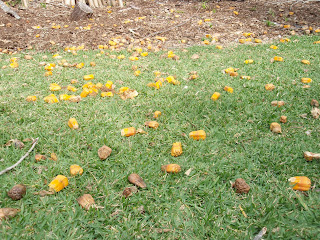![]()
![]()
Before we moved into town my previous garden was large. Every autumn and spring I would add another patch, another bed, some trees here and there, more fruit trees, windbreaks or wildlife corridors, despite having promised myself in the previous summer that I would not do so. Water was a big constraining factor because we relied on our dams for garden water and during dry summers the usable water in the dams dropped alarmingly. In some years there was only mud in the bottoms until the long-awaited autumn (or winter) rains began. During all that time (about 23 years), I don't remember giving much thought to how the added beds/patches merged into each other, complemented or contrasted with each other. I was too focused on getting the job done and working out how to keep the new plants watered, mulched and maintained. So, it was more by good luck than by good planning that the garden actually did come together as a pleasing whole. Maybe there was more subconscious planning going on than I was aware of.
![]()
![]()
My present garden is on a smaller scale and, while I still think it makes a lot of sense to develop a patch or bed at a time, I have been much more aware of how each area impacts on the others. I have consciously created pleasing (to me) compositions of plants and garden art. From just about anywhere I stand I can look around and see how the plants and ornamental aspects paint a picture or tell a story.
![]()
![]()
![]()
![]()
Decorative elements add so much to the enjoyment of the garden, but place them with care so they look as if they belong there, add to the picture or tell a story. They need not cost a fortune. Most of mine have been requested as birthday presents and many are made from re-used materials, either by local craftspeople or by Rodney. The fence art, for example, was a joint inspiration. I wanted to make a feature on that patch of fence as it is next to a sewer inspection pipe that cannot be planted over. Rodney painted the fence in the background yellow and used leftover roofing material to form hill shapes. A local metalworker made the bird from old agricultural equipment. It has proven to be a talking point admired by everyone who comes here, and I love how it casts shadows on the fence when the setting sun shines on it, so it appears to be two birds, and reflects in the pond after rainfall has filled it.
![]()
The combination of natural elements such as rocks with grasses is particularly pleasing. The rocks in the photo below were obtained as part of a barter deal. A local farmer who had the heavy moving equipment and access to lots of rocks was happy to exchange them for some business cards.
I hope today's garden photos brighten up a gloomy winter's day.



